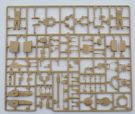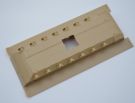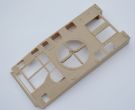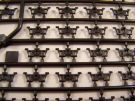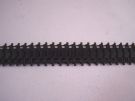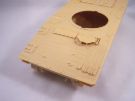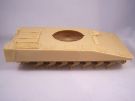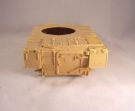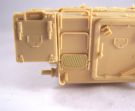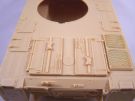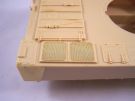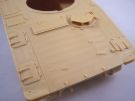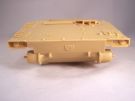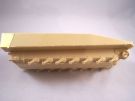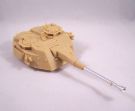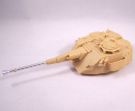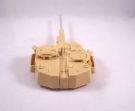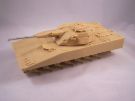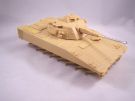CV9040B Academy
Référence: #13217
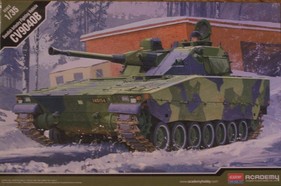
The content
The kit is released by Academy and comprises 5 sand plastic sprues, 2 hull
halves, 2 black plastic sprues for the track links, 1 black plastic sprue for
the track pads, 1 clear plastic sprue, 1 pair of vinyl tracks, 1 sheet of
photoetched parts, 1 sheet of decals, 1 turned aluminum barrel and polycaps.
The carving is good and the level of detail is good too. The fit is quite
satisfactory. Academy gives the option of showing all the hatches open but the
inner faces have numerous ejection marks that will require a lot of work to do
so.
The instruction booklet comprises 12 pages. The first one gives a paint chart
in several brands range. Pages 2 to 10 deal with the assembly. Page 11 gives the
camouflage scheme and the decals placement instructions. Unfortunately it is
black and white. The last page shows the various sprues.
It traditionally starts with the chassis and the running gear. The
roadwheels arms fit well. You just need to check their correct alignment. Polycaps
allow to snap the roadwheels and the sprockets without the need of glue. The outer half roadwheel comes in
two parts because of its particular shape. This will ease the painting process.
In fact, on many pictures of actual CV90s, we can notice that the rim often
appears in bare aluminum. The inner face of the inner roadwheels is detailed
which is quite rare.
At step 4, the black-out lights E7 do not fit well with the headlight blocks E5
and E6. You need to sand them a bit.
The rear panel is an easy job. Academy gives the option of building the door
open or closed. The hinges parts are different according your choice. As stated
above, the door inner face has ejection marks to fill. However, as there is no
interior, fixing the door won't be enough.
The lower part of the skis rack is given as either a single plastic part or a
plastic frame with a PE mesh part to glue on. This option is more realistic.
It is advised not to glue the antenna E53 as this stage to avoid breaking it.
The upper hull is nicely molded and shows anti-slip surfaces. All the hatches
come as separate parts. The driver one as 3 vision blocks which can be put aside
waiting for the painting. The upper swinging arm prevents the hatch to fully
open.
On the roof behind the turret, Academy omitted to represent the towing cable and
its brackets. The troop compartment hatches can be shown open. In this case, you
must not glue the hatch halves as a single large hatch but have them folded.
The turret comes in two parts, a ring with lugs to fix it to the hull and the
turret.
The antennas bases look too thin and could be replaced by others. The 6 Galix tubes have an ejection mark that you need to fill.
The vehicle commander hatch has a mobile hinge system. Unfortunately, to keep
it working you have to sand the hinges D21 and D22. The lock D47 should be glued
offset too.
The gunner sight comes as a clear part. It is protected by an armored housing.
it is necessary to paint the sight and the inside of the housing prior to gluing
the parts. The shutter of the housing can be displayed open or closed.
The 40mm cannon comes as either a single plastic part or an aluminum tube on
which are glued a plastic collar and a recoil sleeve. The cannon assembly allows
3 possible elevations. However the dust cover D16 is designed for a gun at the
horizontal. Its simple design allows to the average model builder to modify it
for the desired elevation.
The CV9040 is fitted with a 7.62mm coaxial MG which is not issued by Academy.
The build ends with the assembly of the both hull halves and the tracks. The
bravest will choose the separate links tracks. However the work will be
important as it needs on the one hand to glue each trackpad and on the other
hand to fill the both ejection marks on the inner track link faces. Even if you
do it for the visible track links only it will be time consuming. Moreover, the
detail is not really better than on the vinyl tracks. For example, the track
pins retaining bolts are not present. But these tracks will help representing
the sagging due to the absence of return rollers.
The vinyl tracks can't be glued. You need to melt them like the old tracks in
the 70-80s. They are too long and must be shortened by two links. However the
junction will be hidden by the side skirts.
The decoration
A single scheme is proposed by Academy. It is the 3-tone black, dark green
and light green splinter scheme. The decal sheet gives two registration numbers
without any unit indication.
Conclusion
This kit builds quite
easily into a Swedish vehicle based in Sweden only. Some CV9040B were deployed
to Liberia but they were slightly modified. You'll need to make those
modifications from scratch. In this purpose, it will be useful to refer to the
booklet published by Tankograd.




